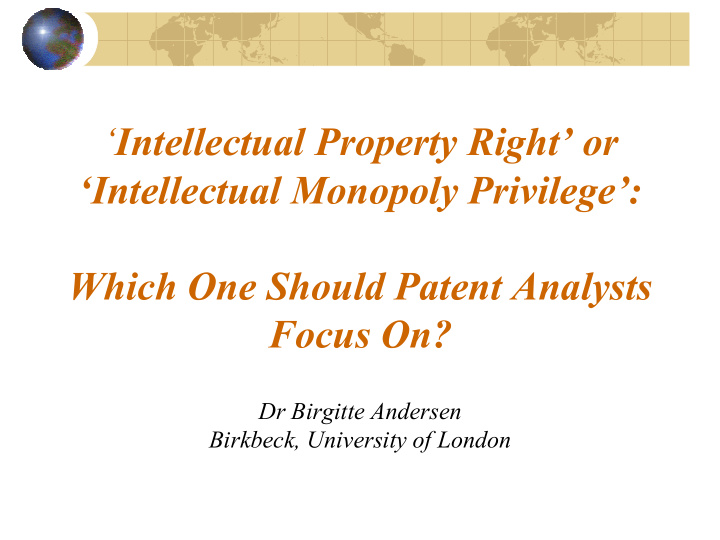



‘ Intellectual Property Right’ or ‘Intellectual Monopoly Privilege’: Which One Should Patent Analysts Focus On? Dr Birgitte Andersen Birkbeck, University of London
Why this is an important question! The (controversial) role IPR plays as incentive system for different firms and industries, and public vs private sectors, is well researched (see Roberto Mazzoleni and Richard Nelson 1998 for overview on the debate). However, the (controversial) role IPRs play in stimulating competition (another rationale of the IPR system) is less well researched. We are currently tightening the IPR system, but: • The power of patents in competitive (and collaborative) games is not well documented • The social and economic effects of IPRs regarding corporate and sectoral performance are not well documented
Central for business analysts This debate is central for business analysts advising (i) Industrialists enforcing certain industry structures and intra-industry competition/collaboration, (ii) Investors or venture capitalists investing in patent protected blueprints (iii) Policy makers designing the law and economics agenda for the business and society, as well as competition or anti-trust law • Impact on the analytical frameworks we apply to understand the social and economic effects of the IPR policy tool, as well as to understand business environments under IPR regulation.
Mainstream view as presented in the law and economics literature Patents do NOT confer monopolies but they are merely competitive properties (Edmund Kitch 1986, 2000; Robert Merges 2000) THE ECONOMIC PRINCIPLES VIEW: • A patent grants an exclusive right on an idea. • A patents do not grant a monopoly which is protection from competition . THE EMPIRICAL VIEW: • As there is generally not a one-to-one mapping of patent protected blueprint and a product, or one owner of a bundle of technologies feeding into a single product, the holder of a patent holds no significant power in the product market.
→ Implication is that it is OK to tighten the IPR system…. Such conclusions do not provide any serious worries about the tightening and increased enforcement of the patent system that we are currently experiencing in the global economy. • Integrating new areas of protection even beyond science based principles (e.g. business methods patents in the US) • Exclusive rights also on pure ideas (e.g. genetic codes and some mathematics), • increased period of protection, as well as • ‘Submarine’ patenting-scheme in the U.S. • The Trade Related Aspects of Intellectual Property Section (TRIPS) of the World Trade Organization • The Bayh-Dole Act in the US in 1980 to create incentives to patent basic research for transferring new technology from university laboratories to the private sector; • New financial frameworks from the 1980s where unprofitable firm can be listed on Nasdaq as long as they are able to report intangible assets; etc.
Aim of article To provide a challenge to the existing mainstream law and economic literature on the topic. By applying an evolutionary economics perspective , combined with a modern view on conceptualising our production function , I argue that • patents should be viewed as monopolies in most cases, and how such rights can produce significant social costs to business and society and adversely affect the dynamics of innovation systems.
Law and economics: As there is generally not a one-to-one mapping of patent protected blueprint and a product, or one owner of a bundle of technologies feeding into a single product: ~ The holder of a patent holds no significant power in the product market. ~ The conventional monopoly framework of analysis becomes inappropriate to use. Problem: The truly private aspect of technology: Embeddedness • Markets for blue-prints versus markets for technology • Technological factor substitution problem • Technological complexity does not reduce (but increase) power of patents
Law and economics: There is no demand curve as such for a patent, as there is only one patent of exclusive use, so there is only one price reflecting a demand point as opposed to a curve. Consequently, we cannot map the demand curve for a specific product reflecting different combinations of quantity and price with the market situation of a specific patent. Problem: Governance structure is complex: Two ways rent is created: • Maximizing rent through positioning (About organization of ownership structures). • Maximizing rent through scope: (About organization of licensing structures)
Law and economics: Although a patent holder under some rare conditions can take advantage of a monopoly situation, there is no explanation on how a patent actually can produce a product monopoly. Problem: The production function is historical rooted and reflects a past society (Awkward treatment of patents: Their market effect are only accounted for when they are embedded in a physical product) • Increasing returns create lock-in to standards • Techno-economic paradigm argument
Monopolistic pricing, social costs and incentives Law and economics: Up-marking is ok as analytical frameworks do not capture all supply side costs. Problem: • What about demand side costs? • Also, better analytical frameworks are needed Law and economics: The system must allow some profit to create incentives to invent Problem: • This is not what the empirical evidence shows for large firms and some industries. • The Schumpeterian head-start profit is sometimes enough
Conclusion Understanding if IPRs confer monopolies or merely competitive properties is a challenging task, especially if we wish to include realistic assumptions of the governance of IPRs at the corporate and sectoral level. This includes considering • Different structures of ownership. • Portfolios of rights (not single rights) in innovation systems. • Licensing possibilities. • Modes of interaction. Finally, the ‘competitive property right’ versus ‘monopoly privilege’ question should not only be confronted on the grounds on the existence of the patent system is beneficial or creates social costs. • We need more insight regarding the most appropriate design .
Recommend
More recommend